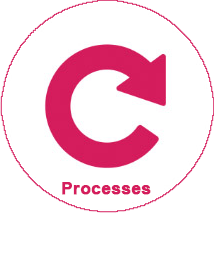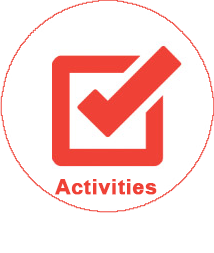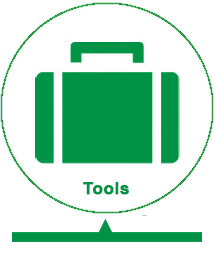The CA-PMF provides a number of resources and tools that project teams can use to help complete the activities included within each process phase of the project. An important part of the Framework is the inclusion of tools in an easy to use format. The tool set is intentionally intuitive, and most tools are configurable so that project teams can adjust them as needed to help manage the project accordingly. Below the resources and tools that are available to help with each of the process phases are listed. To download a specific tool or the complete collection see the templates page.
 Concept
Concept-
A number of project management outputs are developed during the Concept Process Phase. The outputs are associated with tools available for your use.
Tool/ Output
Definition
Concept Development and Readiness Assessment
This template helps the project team determine (1) if an appropriate and complete business case has been developed, (2) if the associated project impacts have been identified, and (3) if the project should be undertaken.
The template will also help to identify the business drivers, problems, opportunities, and objectives the project is intended to address. The written description of these factors outline the information so that it is clear how the project concept aligns with the strategic direction of the organization.
The assessment also provides a determination of the sponsoring organization’s readiness for undertaking and accepting the project results, and an analysis of possible organizational impacts.
Some of the information for the assessment can be leveraged from the Stage 1 Business Analysis (S1BA).High-Level Risk Assessment
A review of the outcomes of the Concept Development and Readiness Assessment produces a high-level risk assessment for the project.
Stage 1 Business Analysis (S1BA) (PAL)
Part of the PAL, the S1BA provides a basis for project management, program management, executive management, and state-level control agencies to understand and agree on business problems or opportunities, and the objectives to address them.
Additional information on the S1BA can be found in the: Statewide Information Management Manual (SIMM) Section 19A.Concept Process Phase Checklist
Identifies the key activities that are to be completed during the Concept Process Phase.
 Initiating
Initiating-
A number of project management outputs are developed during the Initiating Process Phase. The outputs are associated with tools available for your use.
For a complete list of all tools that are part of the CA-PMF see the templates page. A list and definitions of all Templates referenced in the CA-PMF is provided in Which Templates Should I Use and When? section in the Templates chapter.
Tool/ Output
Definition
Project Priorities Template
An assessment tool to be completed for key Stakeholders. The assessment serves to identify the priorities of the project.
Project Charter*
Formally authorizes a project. It describes the business need for the project and the anticipated project results. It formalizes the existence of the project and provides the project with the authority to expend organizational resources to support project activities.
Stakeholder Register
Identifies the organizations and individuals with a role in the project. The Register provides important input for the planning of governance and communication for the project.
RACI Matrix*
Identifies the level of responsibility held by each owner in the creation, review, and approval of project products or documents during each project phase.
Stage 1 Business Analysis (S1BA) (PAL)
Part of the PAL, the S1BA provides a basis for project management, program management, executive management, and state-level control agencies to understand and agree on business problems or opportunities, and the objectives to address them.
Additional information on the S1BA can be found in the Statewide Information Management Manual (SIMM) Section 19A. (link)Complexity Assessments (Oversight)
A self-assessment tool to be completed by the project team. The assessment serves to discover and characterize the business and technical complexities of the proposed project.
Project Status Reports (Oversight)
Includes status reports that communicate the current overall status of a project. It should be distributed to appropriate team members, Stakeholders, and sponsors on a regular basis.
Project Document Approval
This document can be used to circulate documents for review and approval. Attach to those plans and documents that need to be reviewed or signed off. Use is dependent on the project size and scope and the needs of the project team.
Initiating Process Phase Checklist
Identifies the key activities that are to be completed during the Initiating Process Phase.
* There are two versions of these templates available. A standard and a mini. The mini is designed for the smaller of the low complexity projects, pilot projects, and those who are exploring a proof of concept. The standard version is for all other projects.
 Planning
Planning-
A number of project management outputs are developed during the Planning Process Phase. The outputs are associated with tools available for your use.
 Executing
Executing-
A number of project management outputs are developed during the Executing Process Phase. The outputs are associated with tools available for your use.
Tool/ Output
Definition
Project Status Reports (Oversight)
Includes status reports that communicate the current overall status of a project. It should be distributed to appropriate team members, Stakeholders, and sponsors on a regular basis.
Deliverable Expectation Document (DED)
DEDs provide a basis for the development and submission of deliverables. It is a tool to avoid miscommunication, to ensure that the state and contractor possess a mutual understanding about deliverable content and scope.
Work Authorization
Used to authorize the contractor to complete work that is not specifically outlined in the contract, but is aligned with the overall scope of the contract. This work is unanticipated and discovered during the course of the contract, and funds must be available in the contract.
Process Improvement Plan
Identifies quality management-specific standards and practices, assessment, monitoring, and correction of the core Project Management processes followed by the project.
Operational Readiness Assessment (ORA)
Is part of the transition of the project’s software release or other end product to Maintenance & Operations and the production environment. The assessment provides and documents a comprehensive analysis of all facets of readiness, including organizational readiness and contingency planning, prior to the implementation.
Formal Product Acceptance
Used by project teams to document formal acceptance of a major deliverable, phase, or completion of the project.
Sponsorship Commitment Survey
Used by project teams to assess the involvement and support provided by the Project Sponsor.
Team Effectiveness Survey
Used by project teams to assess the effectiveness of how the project team works together.
Executing Process Phase Checklist
Identifies the key activities that are to be completed during the Executing Process Phase.
 Closing
Closing-
A number of project management outputs are developed during the Closing Process Phase. The outputs are associated with tools available for your use.
Tool/ Output
Definition
Lessons Learned
The lessons learned documentation represents knowledge and experience gained during the project. It documents how project events were addressed, and how they should be addressed in the future, with the purpose of improving future performance.
Project Status Reports (Oversight)
The final Project Status Report communicates an appraisal of project closing activities to the Project Sponsor(s) and key Stakeholders identified in the Communication Management Plan. This also concludes the reporting of project status and tasks and makes note of issues or items that will be handled once the project has been closed.
Project Closeout Report
The project closeout report documents the final and remaining activities of the project.
Post Implementation Evaluation Report (PIER) (Oversight)
The PIER must be submitted to the Department of Technology (CDT) within the Department’s required time frame. It contains six sections:
Background and Summary of Results
Attainment of Objectives
Lessons Learned
Corrective Actions
Project Management Schedule
Economic Summary
Closing Process Phase Checklist
Identifies the key activities that are to be completed during the Closing Process Phase.
 Post Launch Support
Post Launch Support-






